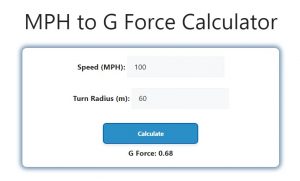About MPH to G Force Calculator (Formula)
An MPH to G-force Calculator is a handy tool to convert speed from miles per hour (MPH) into G-force, a measure of acceleration relative to gravity. This is particularly useful in fields like automotive performance, aviation, and rollercoaster design, where understanding the G-forces experienced at different speeds is critical.
Formula
The formula to convert MPH to G-force is as follows:
Gf = (V / 2.237)^2 / R / 9.81
Where:
- Gf is the G-force
- V is the velocity in MPH
- R is the radius of the turn (in meters)
- 9.81 is the gravitational constant (m/s²)
- 2.237 is the conversion factor from MPH to meters per second
How to Use
To use an MPH to G-force Calculator:
- Enter the velocity in MPH (V) into the calculator.
- Input the radius of the curve or turn (R).
- The calculator will then apply the formula to compute the G-force experienced during the motion.
Example
Let’s calculate the G-force for a vehicle moving at 60 MPH around a curve with a radius of 100 meters.
- V = 60 MPH
- R = 100 meters
Using the formula:
Gf = (60 / 2.237)^2 / 100 / 9.81
Gf = (26.82)^2 / 100 / 9.81
Gf ≈ 0.73
In this example, the G-force experienced is approximately 0.73 G.

FAQs
- What is G-force?
G-force is a measure of acceleration relative to the force of gravity. It describes how much force an object feels compared to the normal force of gravity. - What does the formula calculate?
The formula calculates the G-force experienced by an object based on its speed (in MPH) and the radius of the turn or curve. - Why do we divide by 9.81 in the formula?
9.81 m/s² is the standard gravitational acceleration on Earth, and we divide by it to express acceleration in terms of G-force, which is relative to Earth’s gravity. - What does the conversion factor 2.237 represent?
2.237 is the conversion factor used to change speed from miles per hour (MPH) to meters per second (m/s), as the formula requires velocity in m/s. - Can I use this formula for any speed?
Yes, this formula works for any speed in MPH, as long as the radius of the turn is known. - What happens to G-force if the radius (R) decreases?
If the radius decreases, the G-force increases because the object is turning more sharply, resulting in higher acceleration. - What is the significance of the radius (R) in the formula?
The radius represents the size of the turn or curve. A smaller radius means a sharper turn, leading to higher G-forces. - Is there a maximum G-force that humans can tolerate?
Humans can typically tolerate up to about 9 Gs for short periods, though prolonged exposure to high G-forces can cause injury. - Can this formula be used in aviation?
Yes, this formula is commonly used in aviation to calculate the G-forces experienced by aircraft during maneuvers. - How does speed affect G-force?
As speed increases, the G-force also increases, since acceleration is proportional to the square of the velocity. - Can the MPH to G-force formula be applied in roller coaster design?
Yes, the formula is often used in roller coaster design to ensure safety by calculating the G-forces experienced by riders. - Does the formula consider the mass of the object?
No, this formula calculates G-force based solely on velocity and radius, independent of the object’s mass. - Can I use this formula for straight-line motion?
No, this formula is specifically for circular or curved motion where G-forces are generated due to changes in direction. - What happens if G-force becomes too high?
Excessive G-forces can cause discomfort, loss of consciousness, or physical harm, especially in high-speed activities like racing or flying. - How do I measure the radius of a turn?
In most practical scenarios, the radius of a turn is measured based on the curvature of the path an object is traveling. - Why is G-force important in motorsports?
G-force is crucial in motorsports because it affects vehicle handling and driver safety, especially during high-speed turns. - What units are used for velocity and radius in the formula?
Velocity is in miles per hour (MPH), but it’s converted to meters per second (m/s) in the formula. Radius is measured in meters. - Can G-force be negative?
Yes, G-forces can be negative, which occurs during deceleration or when moving in the opposite direction to gravity. - Does G-force impact fuel efficiency?
Indirectly, yes. High G-forces can result from aggressive acceleration or deceleration, which may lead to increased fuel consumption. - What is the relationship between G-force and inertia?
G-force is a manifestation of inertia, where an object resists changes in motion. In high G-force scenarios, inertia makes it harder for objects to maintain their current speed or direction.
Conclusion
The MPH to G-force Calculator is a powerful tool that allows users to calculate the G-forces experienced during curved or circular motion based on speed and radius. Understanding G-force is crucial in a wide range of industries, from automotive design to aviation. By using the provided formula, you can estimate the forces acting on an object and ensure safe performance in high-speed environments.